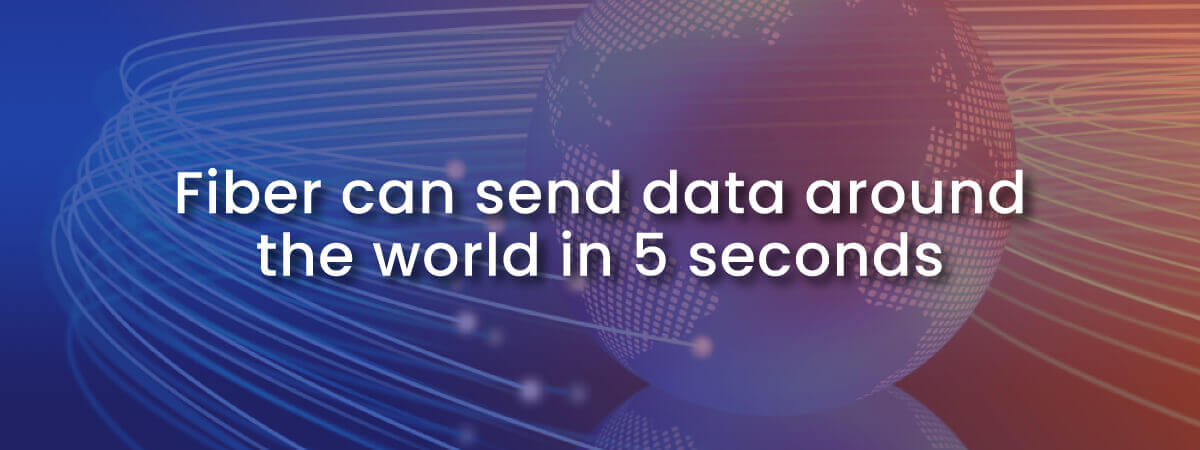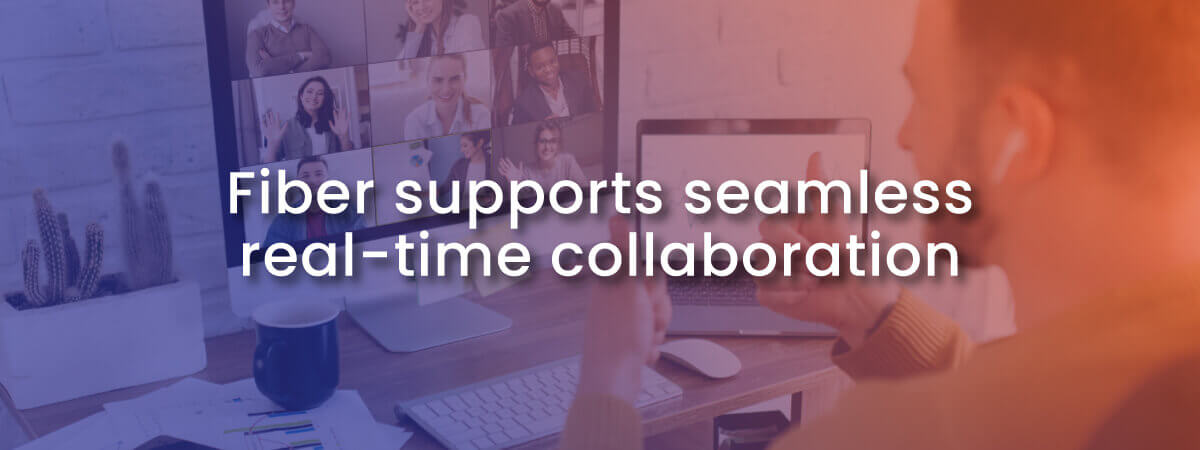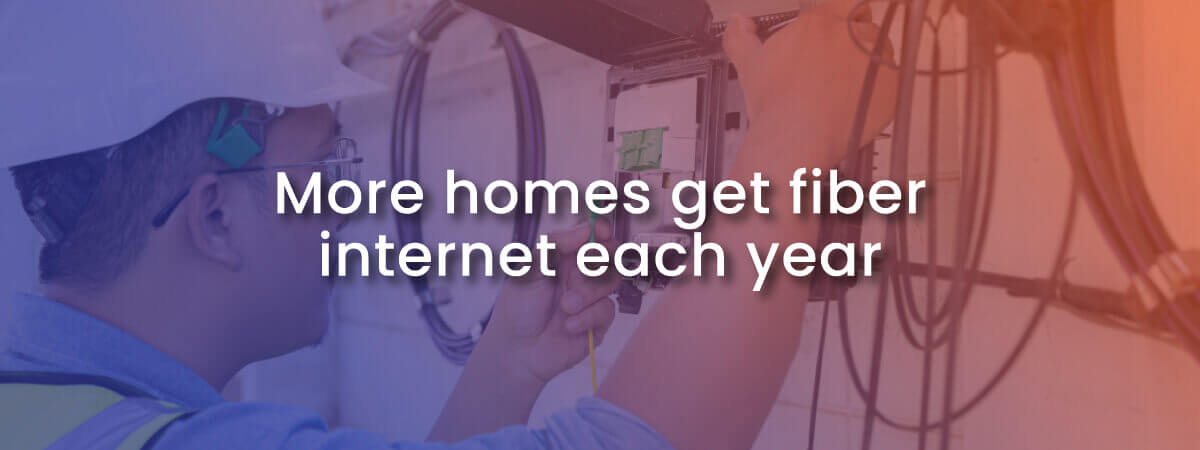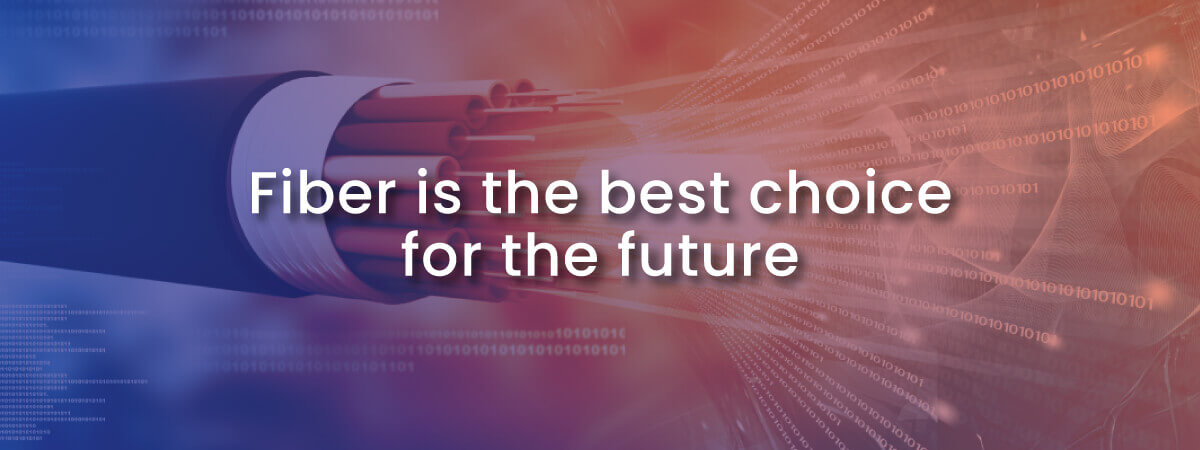Why Fiber Internet for Remote Work is a Game Changer
Table of Contents
Remote work has been around for years. But in 2020, over one-third of the American workforce switched over to remote work during the COVID quarantine. Little did we know then that the pandemic would transform the way we work— for the better.
Working from home was challenging for many people at first, especially for those with young children. But organizations and employees also saw major advantages and cost savings from remote work.
Remote work has now become the new normal for millions of workers in the United States. A staggering 58% of workers work remotely at least one day a week. Thirty-five percent of American workers have the option to work from home for five days a week.
Remote work requires a fast and reliable internet connection. For speed and consistency, no internet technology can beat fiber-optic internet.
This article will explore all the benefits of switching to fiber internet for remote work. If you work from home or would like to transition to a remote job, switching to fiber would be a smart move. Here’s why.
Why Fiber Internet is Faster
Fiber internet is a broadband internet connection that uses fiber-optic cables to transmit data. These cables are made of thin strands of glass or plastic. They transmit data by sending light signals across huge distances at unprecedented speeds.
Though many articles will describe the speed of fiber as “lightspeed,” that description isn’t quite accurate. The average speed of a fiber transmission tends to be not full lightspeed, but about 69% of lightspeed.
Disappointed that it’s not full light speed? Well, here’s how fast that average fiber internet speed is. At 69% of light speed, your data can circle the Earth five times in one second.
If you’re curious about fiber technology, see our full article on how fiber internet works.

Fiber Internet vs. Traditional Internet
Traditional internet connections such as DSL and cable internet use copper wires and cables to transmit data. While these connections are widely available, they are much slower and less reliable than fiber. Copper wires can’t transmit electrical signals nearly as fast as fiber-optic lines can send light signals.
Copper wires used in DSL internet can experience interference from nearby electrical devices such as TVs, radios, and microwaves. This electromagnetic interference can cause poor internet signal quality and even disconnection. Coaxial cables used in cable internet are also vulnerable to interference from nearby devices.
But fiber-optic lines are resistant to electromagnetic interference, which makes fiber much more reliable for data transfer.
How Fiber Internet is Revolutionizing Remote Work
Fiber internet technology is transforming remote work with better connectivity, massive bandwidth, and low latency. Because fiber makes workflow so much smoother and faster, remote workers can increase their productivity.
Fast and reliable connectivity
Fiber internet offers faster and more reliable connectivity than traditional internet connections. With fiber, remote workers can enjoy seamless access to cloud-based applications, video conferencing, and other online tools without experiencing lag or buffering.
Bandwidth capabilities
Fiber internet offers higher bandwidth capabilities than traditional internet connections. More bandwidth means that remote workers can upload and download large files quickly and easily.
Faster transfer is a lifesaver for those who work with large files, such as graphic designers, video editors or anyone whose work includes graphics or large documents.
Bandwidth is also crucial to run today’s software. Many common apps that support remote teamwork maintain a constant connection, which means they use a share of bandwidth at all times. Fiber is better able to support these background connections without glitching or freezing.
Low latency
Latency describes how much delay there is in an internet signal as it travels from one point to another across the internet. You can think of latency as “lateness.” Though the actual delay or lag from latency is usually very small, it can still cause problems, especially in real-time activities.
Fiber internet has lower latency than traditional internet connections due to its superior speed, bandwidth, and lack of electromagnetic interference. With fiber, remote workers can enjoy a more responsive and real-time experience when using online tools.
Increased productivity
Fiber improves workflow by providing smooth support for many of the tools you need in today’s digital work world.
Fiber internet enables remote workers to complete tasks quickly and efficiently, which then increases productivity.

Benefits of Fiber Internet for Remote Work
The high speed, bandwidth, and low latency of fiber internet all work together to produce clear advantages for remote workers. Here are some of those benefits that make fiber internet the game changer for remote work.
Seamless real-time collaboration
Fiber internet offers unparalleled performance for any internet activity involving real time collaboration.
With fiber, you’ll have lag-free video conferencing, which is essential for remote workers who need to collaborate with their colleagues or attend virtual meetings. You can enjoy high-quality video and audio without experiencing glitching or buffering.
Communication tools such as Teams, Slack and Zoom all offer videoconferencing and other real-time components that work best with high-speed internet and low latency.
Project management tools such as Asana, ClickUp, and Monday need real-time updates throughout the day, so they also benefit from good bandwidth.
Collaboration tools such as Google Docs and Microsoft Office 365 allow workers to share and edit documents and spreadsheets, working together in real-time. Having a fiber internet connection means you won’t get annoying delays while discussing sentence edits or checking calculations with your coworkers.
Fast data transfer
Fiber internet offers fast data transfer, which is essential for remote workers who need to transfer large files such as documents, graphics, or videos. With fiber internet, you can upload and download these files quickly and efficiently, saving time and improving your workflow.
Reliable connectivity
Fiber internet offers more reliable connectivity than traditional internet connections. Fiber-optic cables are more durable and less susceptible to interference from weather or electrical disturbances. As a result, remote workers can enjoy a more stable and uninterrupted internet connection, which is crucial for productivity and efficiency.
Improved work-life balance
Fiber internet can also improve work-life balance for remote workers. With fast and reliable internet connectivity, you can complete your work efficiently, which in turn allows you to spend more time with family or pursue your hobbies and interests.
Leading a more fulfilling and satisfying lifestyle through the combined power of remote work and fiber can have a positive impact on your mental and physical health.
Why Fiber Internet is the Future of Remote Work
Fiber internet is increasingly becoming the preferred choice for remote work. As more companies adopt remote work policies, the demand for fast and reliable internet connectivity will only continue to grow.
Fiber internet is the future of remote work, as fiber can provide the infrastructure to support a seamless and productive work-from-home experience.

Challenges of Fiber Internet Adoption
While fiber internet offers many benefits for remote work, there are still some challenges preventing its universal adoption.
One of the main challenges is that fiber internet is not yet widely available in all areas.
If you don’t yet have access to fiber internet at home, you may get it soon. Companies like Brightspeed are building out fiber infrastructure as rapidly as possible.
Fiber Supports Future Innovation
Fiber internet is revolutionizing remote work by providing fast, reliable, and efficient internet connectivity. With its higher bandwidth capabilities, low latency, and seamless video conferencing, fiber internet is becoming the preferred choice for remote workers and companies.
The rising popularity of remote work means the demand for fiber internet will continue to grow, making fiber the future of remote work.
As technology evolves, we can expect more bandwidth-intensive activities to become common. Augmented and virtual reality applications require even greater bandwidth than current internet activities.
The idea of using VR at work may seem like science fiction, but we would have said the same thing about videoconferencing from home twenty years ago. Videoconferencing is now everywhere. In just a few short years, we may all put on virtual reality headsets for our meetings in 3D virtual conference rooms.
By choosing fiber, you will future-proof your internet connection for remote work. Fiber internet will ensure that you will be able to handle any new digital demands that may arise for years to come.
At a Glance: 5 Reasons to Choose Fiber for Remote Work
- Pure speed: At 69% of the speed of light, fiber is unbeatable for internet speed.
- Symmetrical speeds: Unlike any other internet technology, fiber has equal download and upload speeds.
- Reliability: Fiber is not susceptible to extreme weather or electromagnetic interference
- Security: Fiber is an exclusive connection, which is more secure than a shared connection. Fiber signals are also much harder to intercept physically than the electrical signals of cable or DSL.
- Bandwidth: Fiber can handle not only today’s high-data needs but also any new technology for a decade.

FAQs
What is bandwidth?
Bandwidth is the measure of the maximum amount of data that can be transmitted over a network connection in a given time. Bandwidth is usually measured in bits per second (bps) and determines how quickly data can be sent and received over a network.
Does fiber internet travel at lightspeed?
Fiber-optic cables use light to transmit data, which allows for high-speed data transmission. However, the speed of light through a fiber-optic cable is slightly slower than the speed of light in a vacuum, due to the refractive index of the fiber. The actual speed of data transmission also depends on various factors such as distance, equipment, and network congestion. The average speed of fiber internet is about 69% of the speed of light.
Are there entry-level remote jobs available?
Yes, many companies offer entry-level remote jobs in various fields such as customer service, data entry, and virtual assistance.
Are remote jobs more flexible than traditional jobs?
Remote jobs offer more flexibility than traditional jobs as they allow employees to work from anywhere with a stable internet connection and usually have more flexible work schedules.
How can I find fiber internet for my remote work?
Brightspeed is building fiber infrastructure as quickly as possible. See if Brightspeed fiber is in your area or coming soon.